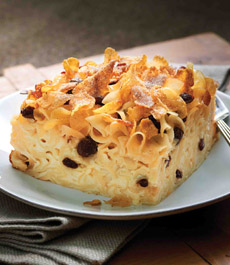TIP OF THE DAY: Make A Kugel
|
The Jewish New Year, Rosh Hashanah*, begins tomorrow night at sundown*. A traditional part of the dinner is kugel (KOO-gull), a casserole-like baked pudding that is served as part of the main course.
The traditional versions in Jewish households are noodle pudding (lokshen kugel), made with egg noodles and raisins; and potato kugel; but mixed vegetable kugels have become very popular in recent decades. In our family’s tradition of excess, Nana always made a noodle kugel and a potato-carrot kugel. We always looked forward to them—especially the sweet noodle kugel—and always requested the crispiest† piece. Nana’s noodle pudding recipe is below. KUGEL HISTORY “Kugel” is a word from Middle High German meaning sphere, globe or ball. The Yiddish name likely originated as a reference to the first versions, baked in round pans to a puffed-up shape. (Today, kugels are often baked in square or rectangular pans.) According to Wikipedia, the first kugels were savory casseroles made from bread and flour. Some 800 years ago, German cooks replaced the bread and flour with noodles or farfel (pellet-shaped pasta like orzo). |

A slice of vegetable kugel, made with carrot, onion, potato and zucchini. Photo courtesy Good Eggs | SF. |
|
|
Eventually eggs were incorporated. The addition of cottage cheese and milk created a custard-like consistency that is common in today’s dessert kugels. Polish Jews added raisins, cinnamon and cottage cheese to their noodle kugels. Jews in different communities developed their own flavors. In Jerusalem, the kugel of choice is a caramelized sugar and black pepper noodle kugel. Here’s a detailed history of kugel. †Bake a noodle kugel for a few extra minutes and the top noodles get crisper. |
||
 Cholesterol conscious? This noodle kugel omits the egg yolks. Recipe courtesy Kitchen Daily. Here’s their recipe. |
TYPES OF KUGELS
As with casseroles, there are as many types of kugel as there are cooks who conceive them. You may even have enjoyed kugel without knowing it: Baked rice pudding is a kugel (rice kugel). Carrot pudding is a kugel. Savory kugels are most often potato kugels, but broccoli, cabbage, carrots, cheese, spinach, yellow squash and zucchini have become popular (usually with a touch of onion). Like cauliflower and mushrooms? Put them in your kugel. Here’s a link to many savory kugel recipes. Sweet kugels are made with apples, butternut squash, cherries, corn, dried fruits, peaches, pineapple, rhubarb, sweet potatoes and more. You can use any fruit you fancy, from lychee to mango. Check out these sweet kugel recipes. There are flourless Passover kugel recipes that adapt of all of these. |
|
|
RECIPE: NANA’S NOODLE KUGEL (LOKSHEN KUGEL) Ingredients 1. PREHEAT the oven to 375°F. 2. BOIL the noodles in salted water for 4 minutes; then drain. Combine the noodles with the other ingredients (except the almonds) in a large mixing bowl 3. POUR into a greased baking pan, 9″ by 13″ baking dish (substitute 9″ by 9″ square pan). Sprinkle the optional almonds over the top. Bake until the custard is set and the top is golden brown, about 30 to 45 minutes. |
||